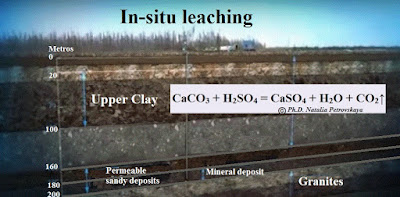Marine, coastal-marine and river placers containing REE
there are:
- Monazite (the monazite sand) in Australia,
Brazil, India, the United States (Florida, North Carolina and South Carolina,
Idaho, Virginia, Colorado), Malaysia, South Africa, Sri Lanka, Mozambique,
Thailand, China, Madagascar, Spain, France.
- Xenotime in Australia, Malaysia, Thailand,
Brazil, China.
- Euxenite and fergusonite in the United
States (Idaho) and China.
- Eudialyte in the United States (Idaho).
To extract minerals from REE placers one can use
environmentally friendly and cheaper technologies. Since the placers are small
particles, there is no need to apply crushing and grinding.
Current and future processing schemes of placer minerals
are included usually several ways of gravity separation of minerals to produce
a collective concentrate (schlich, heavy concentrate). The tails of
placer minerals don’t accumulate. The tails return to the ocean in a secure
form (in the same form as the original raw material). Next may be used a
combination of advanced methods of wet and dry separation of minerals. The
schemes of REE ore processing may be different by sequence of operations
depending on the mineral composition of placer. I would not recommended the use
of flotation for the separation of REE placers due to the formation of harmful
tailings. Today, there are environmentally friendly methods of mineral
separation.
The processing of placer deposits of REE has many
advantages:
1. Processing of placer deposits of REE
is produced by environmentally friendly technology without the use of any
chemicals. Virtually no negative impacts on the flora and fauna of the ocean
and coastal areas.
2. Processing of placer deposits
decreases the radiation background at the shores of seas and oceans. The
ecological situation is improving becourse radioactive minerals are removed
from the beaches. Beaches become a beautiful light color.
3. Good working conditions without dust and
chemical vapours.
4. Perhaps the complex use of raw
materials and the obtaining of several concentrates, which increases profit.
5. The use of cheap technology.
6. Low cost of search and exploration of placer
deposits. One deposit can be used for long time. Ocean continuously feeds new
portions of raw materials without a limit.
7. There are no the costs for the construction
of the quarry or mine.
8. Low construction costs for the processing
plant. One floating plant – the marine dredge can be used for 50 years and more at the
numerous placer deposits.
9. There are no the costs of crushing and
grinding.
10. There are no the waste rock dumps, tailings
containing hazardous and radioactive waste. There are no the costs for it.
11. There are no the costs of restoring the site.
12. Fresh water is not used. There are no the costs
of preparation and purification of fresh water. Separation is made directly in
seawater. Not any chemicals or minerals pollute the seawater.
The processing of placer deposits of REE has the
following disadvantages:
1. Relatively low content of REE in
placer ores. Recycling is economically viable only with preparation of several
concentrates.
2. Relatively small ore reserves in the
deposit field in the beach.
3. Some level of radioactivity of the monazite
beaches. The basic mineral is monazite, which is due to the present of the
radioactive thorium. Monazite sands of India (10% ThO2),
Brazil (5% ThO2) Sri Lanka (20% ThO2) are more
radioactive then others.
4. Monazite
concentrate from placer deposits is also radioactive and requires additional
safety measures.
5. Some REE manufacturers have refused to buy
the monazite concentrate, since it produces a lot of processing waste with thorium, which
requires additional expenditure on storage.
6. Today they use the relatively primitive old
technology at the processing of the alluvial REE ores. New equipment can allow
obtaining additional concentrates simultaneously with the main, but it is not
considered at the development of processing technologies now.
7. As a rule, they get heavy concentrate at the
marine dredge, and the rest of the separation is produced on land. It is
necessary to build deep-processing mineral plant at the shore (with new
equipment and the promising technology, it is not needed).
8. The mining processes are significantly
affected by weather conditions (storms, hurricanes and etc.), which complicate
the work of the marine dredge or make it impossible at certain season.
9. Relatively small companies are
involved at the development of the placer mining and processing; they don’t
have a full cycle of REE processing. That is, they are produced and sold
concentrates instead of metals. Concentrates are much cheaper than metal.
10. Typically, extraction of alluvial
REE ores produced in the shallows, where the content of the components is not
stable. Today, however, the placer mining is possible from the seabed at a
depth large enough (on the shelf), there the content of valuable components is
more stable and there are more reserves of ore.
11. There are not a sufficient number of
specialists of the processing of alluvial REE deposits.
Development of marine placers are very promising
direction. However each placer deposit has its own individual characteristics.
Each REE ore must have its own individual technology. It is solution of
tomorrow day.













